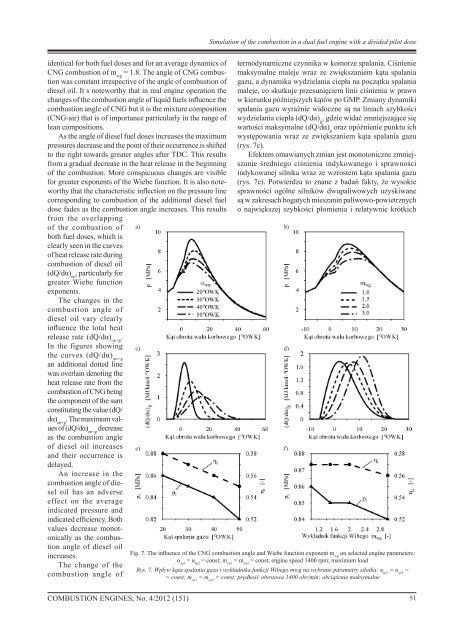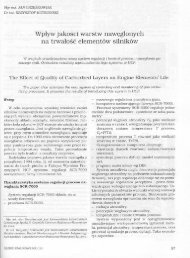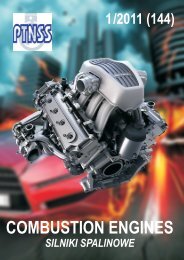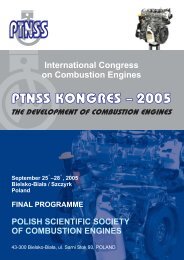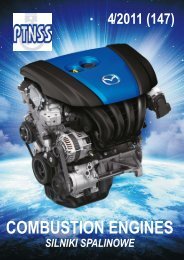You also want an ePaper? Increase the reach of your titles
YUMPU automatically turns print PDFs into web optimized ePapers that Google loves.
Simulation of the combustion in a dual fuel engine with a divided pilot dose<br />
identical for both fuel doses and for an average dynamics of<br />
CNG combustion of m wg<br />
= 1.8. The angle of CNG combustion<br />
was constant irrespective of the angle of combustion of<br />
diesel oil. It s noteworthy that in real engine operation the<br />
changes of the combustion angle of liquid fuels influence the<br />
combustion angle of CNG but it is the mixture composition<br />
(CNG-air) that is of importance particularly in the range of<br />
lean compositions.<br />
As the angle of diesel fuel doses increases the maximum<br />
pressures decrease and the point of their occurrence is shifted<br />
to the right towards greater angles after TDC. This results<br />
from a gradual decrease in the heat release in the beginning<br />
of the combustion. More conspicuous changes are visible<br />
for greater exponents of the Wiebe function. It is also noteworthy<br />
that the characteristic inflection on the pressure line<br />
corresponding to combustion of the additional diesel fuel<br />
dose fades as the combustion angle increases. This results<br />
from the overlapping<br />
of the combustion of<br />
both fuel doses, which is<br />
clearly seen in the curves<br />
of heat release rate during<br />
combustion of diesel oil<br />
(dQ/dα) on<br />
, particularly for<br />
greater Wiebe function<br />
exponents.<br />
The changes in the<br />
combustion angle of<br />
diesel oil vary clearly<br />
influence the total heat<br />
release rate (dQ/dα) on+g<br />
.<br />
In the figures showing<br />
the curves (dQ/dα) on+g<br />
an additional dotted line<br />
was overlain denoting the<br />
heat release rate from the<br />
combustion of CNG being<br />
the component of the sum<br />
constituting the value (dQ/<br />
dα) on+g<br />
. The maximum values<br />
of (dQ/dα) on+g<br />
decrease<br />
as the combustion angle<br />
of diesel oil increases<br />
and their occurrence is<br />
delayed.<br />
An increase in the<br />
combustion angle of diesel<br />
oil has an adverse<br />
effect on the average<br />
indicated pressure and<br />
indicated efficiency. Both<br />
values decrease monotonically<br />
as the combustion<br />
angle of diesel oil<br />
increases.<br />
The change of the<br />
combustion angle of<br />
a) b)<br />
c) d)<br />
e) f)<br />
termodynamiczne czynnika w komorze spalania. Ciśnienie<br />
maksymalne maleje wraz ze zwiększaniem kąta spalania<br />
gazu, a dynamika wydzielania ciepła na początku spalania<br />
maleje, co skutkuje przesunięciem linii ciśnienia w prawo<br />
w kierunku późniejszych kątów po GMP. Zmiany dynamiki<br />
spalania gazu wyraźnie widoczne są na liniach szybkości<br />
wydzielania ciepła (dQ/dα) g<br />
, gdzie widać zmniejszające się<br />
wartości maksymalne (dQ/dα) g<br />
oraz opóźnienie punktu ich<br />
występowania wraz ze zwiększaniem kąta spalania gazu<br />
(rys. 7c).<br />
Efektem omawianych zmian jest monotoniczne zmniejszanie<br />
średniego ciśnienia indykowanego i sprawności<br />
indykowanej silnika wraz ze wzrostem kąta spalania gazu<br />
(rys. 7e). Potwierdza to znane z badań fakty, że wysokie<br />
sprawności ogólne silników dwupaliwowych uzyskiwane<br />
są w zakresach bogatych mieszanin paliwowo-powietrznych<br />
o największej szybkości płomienia i relatywnie krótkich<br />
Fig. 7. The influence of the CNG combustion angle and Wiebe function exponent m wg<br />
on selected engine parameters:<br />
α sp1<br />
= α sp2<br />
= const; m on1<br />
= m on2<br />
= const; engine speed 1400 rpm; maximum load<br />
Rys. 7. Wpływ kąta spalania gazu i wykładnika funkcji Wibego mwg na wybrane parametry silnika: α sp1<br />
= α sp2<br />
=<br />
= const; m on1<br />
= m on2<br />
= const; prędkość obrotowa 1400 obr/min; obciążenie maksymalne<br />
<strong>COMBUSTION</strong> <strong>ENGINES</strong>, No. 4/2012 (151)<br />
51


